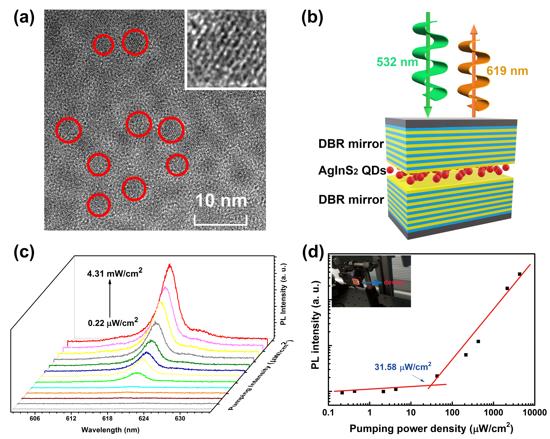
Solution-processed colloidal I-III-VI2 quantum dots (QDs) have been broadly studied in solar cells, photocatalysts, photodetectors, thermoelectrics fluorescent biomolecular tags, and light emitting diodes (LEDs), because of their superior optoelectronic properties such as easy chemical processability, good stability, biocompatibility, tunable band gaps and high absorption coefficient. Meanwhile, compared with currently popular perovskite materials, I-III-VI2 QDs is non-toxic and environmentally friendly. Nonetheless, exploiting the potential of this material as gain medium for optical amplification device is still scarce, restricting its application prospect.
Recently, a collaborative research team led by Shanghai Institute of Optics and Fine Mechanics (SIOM) of the Chinese Academy of Sciences (CAS) and Chongqing University had for the first time succeeded in obtaining amplified spontaneous emission (ASE) action by using AgInS2 (AIS) QDs as the gain medium with good performance. Their work was published in J. Mater. Chem. C.
In their experiment, the researchers explored the stimulated properties of the I-III-VI2 colloidal QDs, i.e., the ASE performance. By applying two highly reflective DBRs as resonant cavity together with AIS QDs with high photoluminescence (PL) quantum yield (52%), optical amplification actions were successfully demonstrated.
In addition, to optimize the optical properties of ASE from AIS QDs, the researchers systematically studied the PL including the intensity and PL peak position at different areas of the device and modulated the number of layers of mirrors of DBR to find better device.
Comparing threshold and full width at half maximum (FWHM) of ASE with different device structures, they found the seven-layer DBR was desirable device structure to choose. Furthermore, the ASE of AIS QDs showed narrow FWHM (3.5 nm) with the threshold as low as 31.58 μW/cm2.
All these results uncover significant feasibility of the traditional AIS QDs as photonic resource, simultaneously demonstrating the as-designed devices have huge potential and promising applications for optical amplification.
The work was supported by the Strategic Priority Research Program of CAS, the International S&T Cooperation Program of China, the National Natural Science Foundation of China, and the Open Fund of the State Key Laboratory of High Field Laser Physics.

(a) Transmission electron microscope (TEM) image of AIS QDs. (b) Schematic of the AIS QDs device. (c) Pump-intensity-dependent PL spectra from the device. (d) PL intensity-pumping power density curve for the AIS QD devices. (Image by SIOM)

86-10-68597521 (day)
86-10-68597289 (night)

52 Sanlihe Rd., Xicheng District,
Beijing, China (100864)

